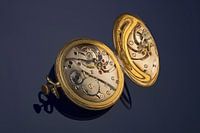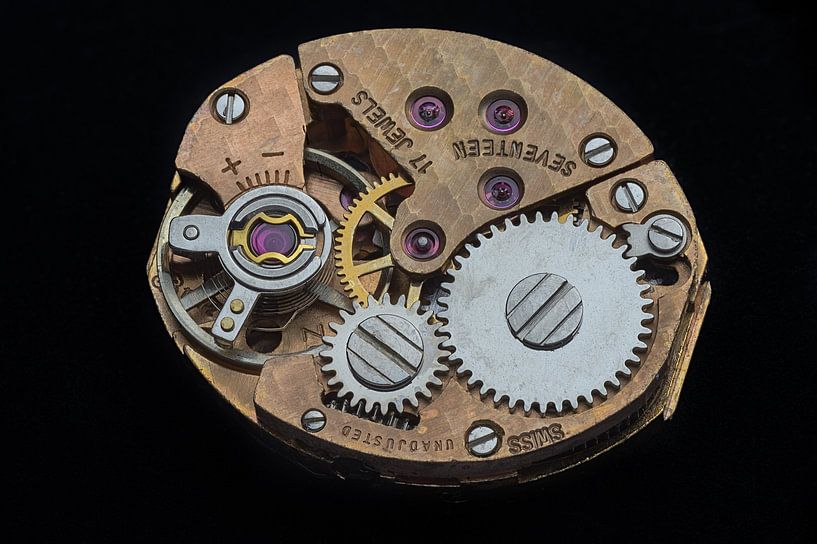Buy the photo Openwork wristwatch by Hans Kool on canvas, ArtFrame, poster and wallpaper, printed on demand in high quality.
About "Openwork wristwatch"
by Hans Kool
About the artwork
The wristwatch was invented by Breguet in 1810 following an order on 8 June that year from Caroline Bonaparte, Queen of Naples.[1] Consequently, at the time, it was mainly seen as women's jewellery. However, in 1790 an account book of the Geneva watchmakers Jacquet-Droz and Leschot already mentions a watch attached to a (women's) bracelet. At the beginning of the 20th century, Brazilian inventor Alberto Santos-Dumont experienced problems reading the time when he flew. He asked Louis Cartier, an acquaintance of his, for a watch that was easier to use. Cartier gave him a watch with a leather strap. Given the popularity Cartier enjoyed in Paris, he also sold other of these watches to men. During World War I, officers in the army found that it was easier to take a quick glance at the wristwatch than to pull out a pocket watch. Added to this, an increasing number of officers died in battle. They were replaced by soldiers who did not have pocket watches. The soldiers had no financial means to buy a pocket watch and thus depended on what the army offered them as watches. This along with the increasing need of the various army units to carry out their actions at the same times caused the army to provide their officers with reliable, but cheap, mass-produced watches. After the war, European and American officers were allowed to keep their watches, thus contributing to the popularity of wristwatches. Today, there is much ambiguity about which arm the wristwatch should be worn on,[2] with the majority of watch wearers being right-handed and wearing the watch on the left wrist. In addition, the wristwatch is worn on the left wrist to avoid shocks from the right hand which is usually used more.

About Hans Kool
Hey! Welcome to my shop at Werken aan de Muur . Due to my travels in Europe, I sometimes have the opportunity to create beautiful images. Dedigital Photography brings more creative possibilities such as panorama photography and increasing the dynamic range of a photo. I use the so-called Digital.. Read more…
 Germany
Germany Ordered in September 2019
Ordered in September 2019
 Germany
Germany Ordered in January 2021
Ordered in January 2021
 Netherlands
Netherlands Ordered in January 2021
Ordered in January 2021
 Germany
Germany Ordered in April 2022
Ordered in April 2022
 Germany
Germany Ordered in November 2024
Ordered in November 2024
 Netherlands
Netherlands Ordered in June 2019
Ordered in June 2019
 Germany
Germany Ordered in August 2022
Ordered in August 2022
 Germany
Germany Ordered in May 2023
Ordered in May 2023
 Germany
Germany Ordered in October 2023
Ordered in October 2023
 Germany
Germany Ordered in May 2019
Ordered in May 2019
 Germany
Germany Ordered in May 2024
Ordered in May 2024
 Germany
Germany Ordered in June 2020
Ordered in June 2020
About the material
ArtFrame™
Interchangeable Art Prints
- High-quality print
- Easily interchangeable
- Acoustic function
- Large sizes available
Discover the artworks of Hans Kool
 The Schie in SchiedamHans Kool
The Schie in SchiedamHans Kool SchiedamHans Kool
SchiedamHans Kool Swiss landscape near LucerneHans Kool
Swiss landscape near LucerneHans Kool MarseilleHans Kool
MarseilleHans Kool GearsHans Kool
GearsHans Kool A Golden Watch...Hans Kool
A Golden Watch...Hans Kool Sagrada FamiliaHans Kool
Sagrada FamiliaHans Kool Golden Gate BridgeHans Kool
Golden Gate BridgeHans Kool The RoosterHans Kool
The RoosterHans Kool Triptych of HydrangeasHans Kool
Triptych of HydrangeasHans Kool Lighthouse, Zeeland, NetherlandsHans Kool
Lighthouse, Zeeland, NetherlandsHans Kool Limerick, IrelandHans Kool
Limerick, IrelandHans Kool Geothermal area of Krýsuvík, IcelandHans Kool
Geothermal area of Krýsuvík, IcelandHans Kool The PeacockHans Kool
The PeacockHans Kool The Baggage Carriers' House, Schiedam, NetherlandsHans Kool
The Baggage Carriers' House, Schiedam, NetherlandsHans Kool The Blue TitHans Kool
The Blue TitHans Kool Exquisite Watch with Open Rear Case: A Masterpiece of Horological CraftsmanshipHans Kool
Exquisite Watch with Open Rear Case: A Masterpiece of Horological CraftsmanshipHans Kool Ceiling and organ of St Stephen's Cathedral (Vienna)Hans Kool
Ceiling and organ of St Stephen's Cathedral (Vienna)Hans Kool Hydrangea with a dark background, made in MadeiraHans Kool
Hydrangea with a dark background, made in MadeiraHans Kool Citroën 2cv4 de Provence, collageHans Kool
Citroën 2cv4 de Provence, collageHans Kool













 Elegant Expressions
Elegant Expressions Industrial
Industrial Photo wallpaper
Photo wallpaper Photography
Photography Vintage
Vintage









